Kenosha Metra station has permit parking; permit sold at lunch counter within station. Located three blocks west of State Hwy 32 at 54th Street and 13th Avenue, and five blocks west of McCarthy Transit Center, bus hub for Kenosa Area Transit buses.
Kenosha and trains for travel are equally enduring, dating from pre-Civil War as an incorporated city and as key station on the first railroad along the west Lake Michigan shoreline.
For about 50 of those years, electric-powered "interurban" trains shared with the Chicago & Northwestern Rwy. the patronage of travelers to and from the community founded as Southport, most southerly of Wisconsin cities on the Lake Michigan shore, most proximate to Illinois and to the city which grew to overshadow all Midwest cities – Chicago, where converging water and land travel were further reinforced as air travel gained dominance in the mid-20th century. But the M-R-K (Milwaukee-Racine-Kenosha) trains vanished soon after World War II, in 1947, and in 1963 North Shore trains (Chicago, North Shore & Milwaukee RR) ended almost a half-century of innovative, speedy operational years.
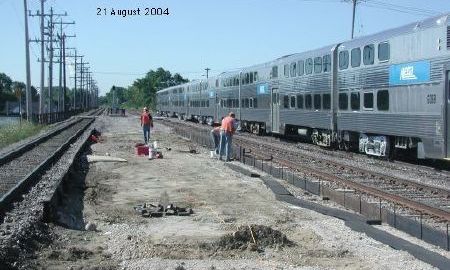 Homes and retail districts built when this Kenosha station platform was long enough for eight coaches remain nearby, but the platform and its canopy have aged less well since construction during the 1930s. Starting in mid-summer, 2004, and for the next two years, Kenosha and its Metra commuter train service acquire a modern platform and access to its elevated location, then modern improvements to its station, at street level. At mid-August,2004 the first half of a new passenger platform takes shape as recently activated Metra coaches provide a backdrop.
Homes and retail districts built when this Kenosha station platform was long enough for eight coaches remain nearby, but the platform and its canopy have aged less well since construction during the 1930s. Starting in mid-summer, 2004, and for the next two years, Kenosha and its Metra commuter train service acquire a modern platform and access to its elevated location, then modern improvements to its station, at street level. At mid-August,2004 the first half of a new passenger platform takes shape as recently activated Metra coaches provide a backdrop.
Kenosha and neighboring cities along the Lake Michigan shoreline of southeast Wisconsin look forward to commuter trains connecting them, and from Kenosha southward to expanded Illinois "Northline" service operated for Metra.
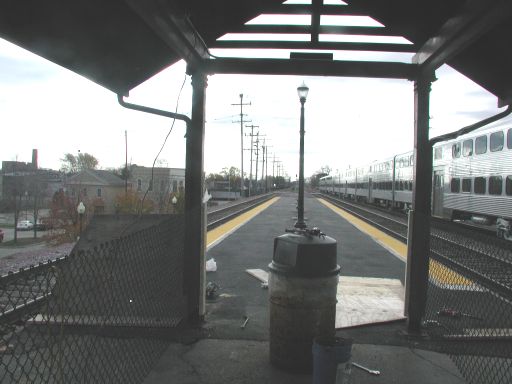 Metra passengers at Kenosha in mid-November, 2004 now have a modern platform – brightly marked warnings stripes, smooth and slip-free surface, and all else – to match their experience at other Metra stations. But only partially, because work has progressed only enough for three coaches to use the much superior, modern surface. Meanwhile, the old platform adjacent to the stairway and beyond (behind) has freshly placed fencing to discourage intrusion into the current work area. Construction in that second area continued for a longer interval, including enough weeks to open an elevator shaft, then installation in 2005 of an elevator for disabled persons.
Metra passengers at Kenosha in mid-November, 2004 now have a modern platform – brightly marked warnings stripes, smooth and slip-free surface, and all else – to match their experience at other Metra stations. But only partially, because work has progressed only enough for three coaches to use the much superior, modern surface. Meanwhile, the old platform adjacent to the stairway and beyond (behind) has freshly placed fencing to discourage intrusion into the current work area. Construction in that second area continued for a longer interval, including enough weeks to open an elevator shaft, then installation in 2005 of an elevator for disabled persons.
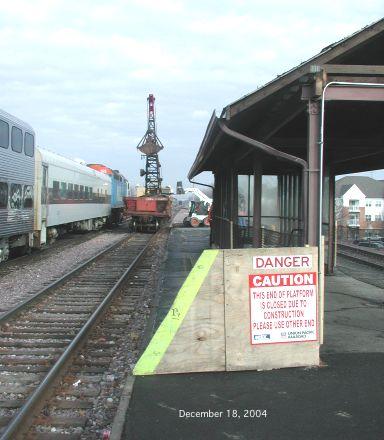 Another day progressing methodically toward renewal of the platorm in mid-December, as a small crew plucks asphalt chunks and loads each into a rail car. Workers will open a new, vertical elevator shaft at the Kenosha station's elevated location.before platform construction is complete.
Another day progressing methodically toward renewal of the platorm in mid-December, as a small crew plucks asphalt chunks and loads each into a rail car. Workers will open a new, vertical elevator shaft at the Kenosha station's elevated location.before platform construction is complete.
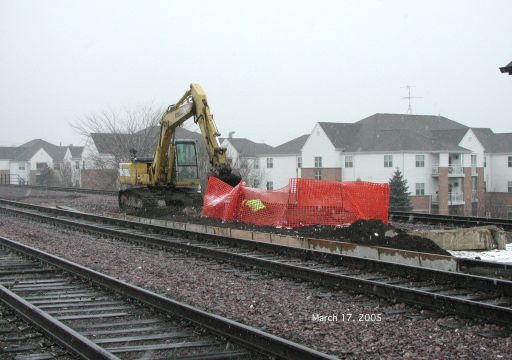
Jolly Irish dancng and celebrating were nowhere to be found around this dig site on St. Patrick's Day, north of the Metra platform in Kenosha where long-buried stairs will resume use.
Construction of an elevator descending to street level will follow later in 2005, allowing ADA-compliant access when completed for Kenosha travelers using Metra.
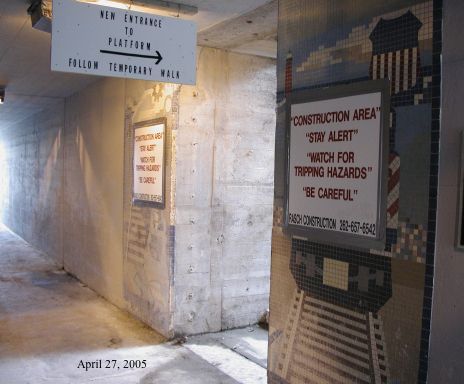 March digging opened access north of the existing Kenosha platform and stairway, though a 1997 mural in the under-track pedestrian tunnel suffers for the work. Another mural greeting Metra riders outside the tunnel remains intact and well-maintained, as it was when K-R-M trains were endorsed in 2002.
March digging opened access north of the existing Kenosha platform and stairway, though a 1997 mural in the under-track pedestrian tunnel suffers for the work. Another mural greeting Metra riders outside the tunnel remains intact and well-maintained, as it was when K-R-M trains were endorsed in 2002.
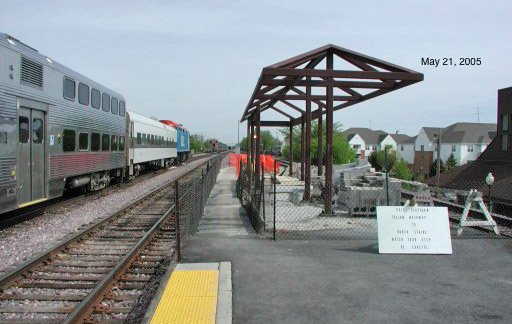
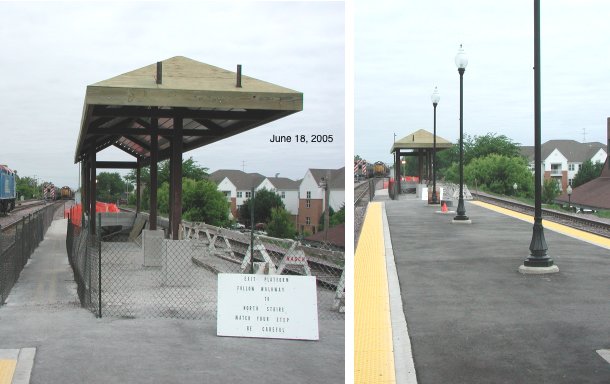
Months of construction added new stairs between street level and elevated platform at Kenosha, north terminus for Metra Northline trains. A construction worker glances (photo below) at the work by his company and previous workers as he strolls toward the active construction area beyond the stairwell. When finished later in 2005, the platform will again access five coaches rather than three, and ADA-compliant access in 2006 will afford all travelers and commuters use of every Metra train. K-R-M trains will extend service from here seamlessly northward to Racine, Cudahy, downtown Milwaukee and four intermediate stops in several years.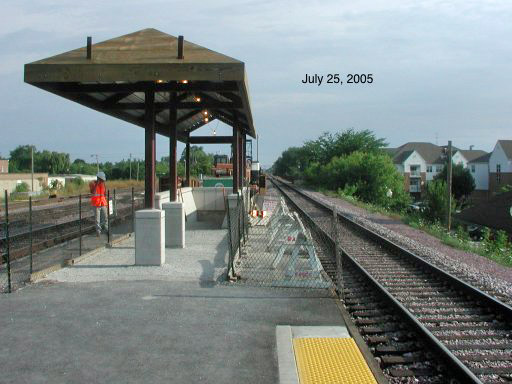
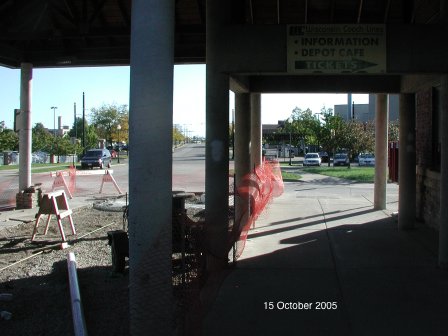 Topside at Kenosha Metra station, platform work paused while an elevator shaft and its hydraulic mechanism are installed. At street level, the station itself awaits architectural proposals for renovation of its heating, plumbing and electrical essentials within its sturdy red brick walls. Direct access to the elevated platform from curbside is narrowed temporarily while newly shaped concrete is poured. In the view eastward above, columns frame 54th Street and three blocks away the morning layover of Kenosha Area Transit buses at the Joseph McCarthy Transit Center, named in honor of the transit director unexpectedly stricken in 2000 as his vision for modernizing the city transit system took a major step into the 21st century. Succeeded by transit director Len Brandrup, the long-underfunded agency continues advancing at a pace designed to provide Kenosha with modern, multi-mode transit for visitors and residents in decades to come.
Topside at Kenosha Metra station, platform work paused while an elevator shaft and its hydraulic mechanism are installed. At street level, the station itself awaits architectural proposals for renovation of its heating, plumbing and electrical essentials within its sturdy red brick walls. Direct access to the elevated platform from curbside is narrowed temporarily while newly shaped concrete is poured. In the view eastward above, columns frame 54th Street and three blocks away the morning layover of Kenosha Area Transit buses at the Joseph McCarthy Transit Center, named in honor of the transit director unexpectedly stricken in 2000 as his vision for modernizing the city transit system took a major step into the 21st century. Succeeded by transit director Len Brandrup, the long-underfunded agency continues advancing at a pace designed to provide Kenosha with modern, multi-mode transit for visitors and residents in decades to come.
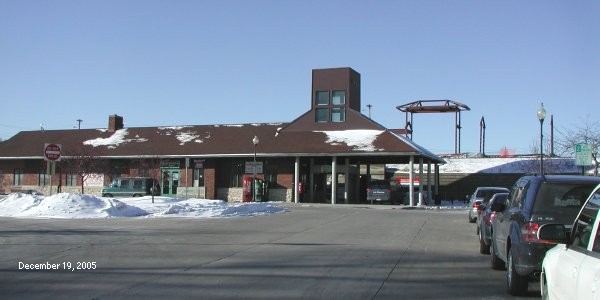
Winter weather blasts ease as March sun warms each day and work proceeds more easily on brick exterior walls and the machinery necessary to emplace a functional elevator between elevated platform and street level. Main tracks must remain clear here for morning rush hour and the single mid-afternoon train presently scheduled. Hourly train arrivals and departures may never busy this platform and its pair of tracks, as tracks are at Waukegan and closer to downtown Chicago.
But increased commuting by train in years ahead will make such obstruction of these tracks for any sort of work far more unlikely.
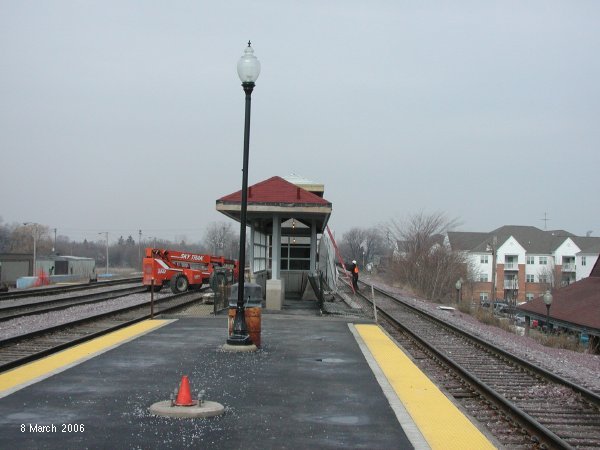
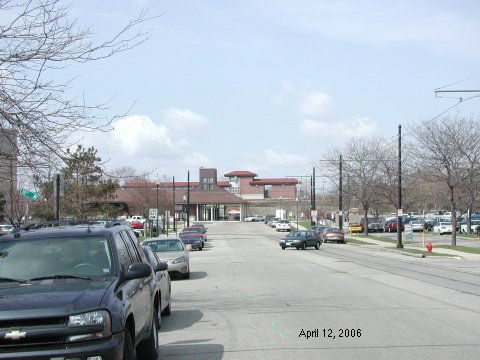 Outdoor improvements to the Kenosha platform and elevator access near completion in mid-April, with pressing need for additional parking to accommodate weekday commuters and weekend day-trippers. A Kenosha County project will approximately double the present 150 off-street.parking spaces developed by City of Kenosha during the 1990s. That increase more than tripled parking to present levels, at a time when Stationside Village residences rose in place of a deteriorated neighborhood.
Outdoor improvements to the Kenosha platform and elevator access near completion in mid-April, with pressing need for additional parking to accommodate weekday commuters and weekend day-trippers. A Kenosha County project will approximately double the present 150 off-street.parking spaces developed by City of Kenosha during the 1990s. That increase more than tripled parking to present levels, at a time when Stationside Village residences rose in place of a deteriorated neighborhood.
KRM extension of commuter train service will further increase parking use here beyond present service, to Chicago and north shore Illinois suburbs. Kenosha-Racine-Milwaukee commuter trains will invigorate lakeshore communities, and other locations have begun preliminary usage dialogues at public meetings. Racine and now Kenosha have been first to improve their stations and surrounding facilities.
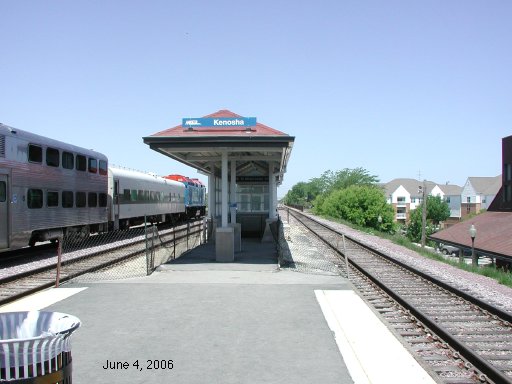
Over a year has passed while Metra riders at Kenosha station used a limited length of platform and train, staying clear of ongoing renewal work. Now as Fourth of July looms less than a month away, the project outdoors nears its end.
Next will be renovation of the station building and modernization of its utilities.
return to KenRail home page
WISERIDE study - genesis of Kenosha-Racine-Milwaukee commuter train project
Wisconsin DOT page for railroad projects
Kenosha Area Transit information, connecting local bus and streetcar service at this station
Racine transit center construction recap (look for later links to other K-R-M station projects)
Metra (Illinois) Northline schedule page